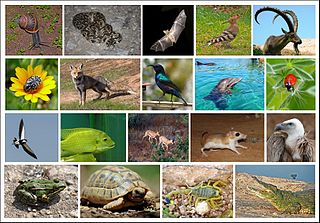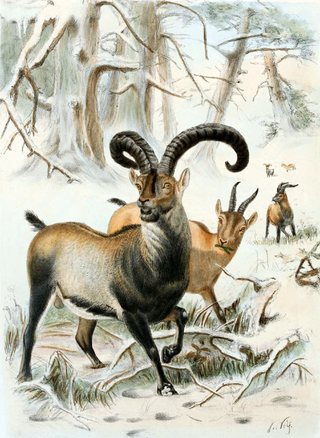
The International Union for Conservation of Nature (IUCN) Red List of Threatened Species, also known as the IUCN Red List or Red Data Book, founded in 1964, is an inventory of the global conservation status and extinction risk of biological species. A series of Regional Red Lists are produced by countries and organizations, which assess the risk of extinction to species within a political management unit.
Local extinction, also extirpation, is the termination of a species in a chosen geographic area of study, though it still exists elsewhere. Local extinctions are contrasted with global extinctions.

The desert rat-kangaroo, also called the buff-nosed rat-kangaroo, plains rat-kangaroo or oolacunta, is an extinct small hopping marsupial endemic to desert regions of Central Australia. It was first recorded in the early 1840s and described by John Gould in London in 1843, on the basis of three specimens sent to him by George Grey, the governor of South Australia at the time.

The New Zealand greater short-tailed bat is one of two species of New Zealand short-tailed bats, a family (Mystacinidae) unique to New Zealand. Larger than the New Zealand lesser short-tailed bat, there have been no confirmed sightings of this species since 1965 and it is considered to be critically endangered, if not extinct. In prehistoric times it lived in the North and South Islands but by the time of European arrival was restricted to small islands near Stewart Island/Rakiura. A rat invasion of Taukihepa/Big South Cape Island in 1963 was thought to have led to the species' extinction, however, recent surveys have raised hopes that the species may still exist.

Nicrophorus americanus, also known as the American burying beetle or giant carrion beetle, is a critically endangered species of beetle endemic to North America. It belongs to the order Coleoptera and the family Silphidae. The carrion beetle in North America is carnivorous, feeds on carrion and requires carrion to breed. It is also a member of one of the few genera of beetle to exhibit parental care. The decline of the American burying beetle has been attributed to habitat loss, alteration, and degradation, and they now occur in less than 10% of their historic range.

Bulmer's fruit bat is a megabat endemic to New Guinea. It is listed as a critically endangered species due to habitat loss and hunting. It is the only member of the genus Aproteles. Due to its imperiled status, it is identified by the Alliance for Zero Extinction as a species in danger of imminent extinction.

The wildlife of Israel includes the flora and fauna of Israel, which is extremely diverse due to the country's location between the temperate and the tropical zones, bordering the Mediterranean Sea in the west and the desert in the east. Species such as the Syrian brown bear and the Arabian ostrich have become extinct in Israel because of their loss of habitat. As of May 2007, 190 nature reserves have been established in Israel.
Mecodema punctellum is a presumed-extinct species of ground beetle of the family Carabidae, endemic to Stephens Island in New Zealand.

A species that is extinct in the wild (EW) is one that has been categorized by the International Union for Conservation of Nature as known only by living members kept in captivity or as a naturalized population outside its historic range due to massive habitat loss.

The saddle-backed Mauritius giant tortoise is an extinct species of giant tortoise in the family Testudinidae. It was endemic to Mauritius. The last records of this tortoise date to the early 18th century.

The domed Mauritius giant tortoise is an extinct species of giant tortoise. It was endemic to Mauritius.

De-extinction is the process of generating an organism that either resembles or is an extinct species. There are several ways to carry out the process of de-extinction. Cloning is the most widely proposed method, although genome editing and selective breeding have also been considered. Similar techniques have been applied to certain endangered species, in hopes to boost their genetic diversity. The only method of the three that would provide an animal with the same genetic identity is cloning. There are benefits and drawbacks to the process of de-extinction ranging from technological advancements to ethical issues.

The Uruz Project had the goal of breeding back the extinct aurochs. Uruz is the old Germanic word for aurochs. The Uruz Project was initiated in 2013 by the True Nature Foundation and presented at TEDx DeExtinction, a day-long conference organised by the Long Now Foundation with the support of TED and in partnership with National Geographic Society, to showcase the prospects of bringing extinct species back to life. The de-extinction movement itself is spearheaded by the Long Now Foundation.
The Capricorn rabbit rat is an extinct species of rodent from Queensland, Australia. It was described as a new species in 2010 on the basis of Pleistocene and Holocene dental remains. The specific name refers to the Capricorn Caves in Queensland, one of the locations where remains were unearthed. Some of the subfossil material post-dates the European settlement of Australia, so the Capricorn rabbit rat is a modern extinction. Since there has not been a targeted survey for the Capricorn rabbit rat, there is a thin hope of its survival, although this is unlikely.











